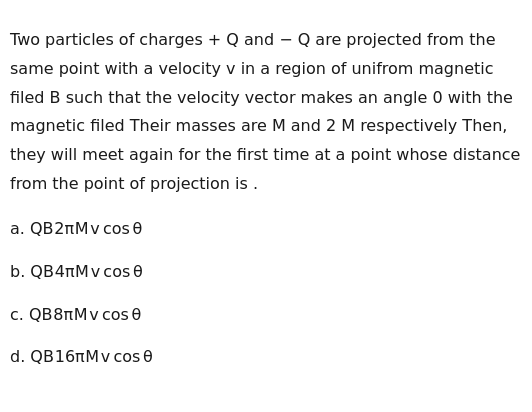Question
Question: Two particles of charges + Q and − Q are projected from the same point with a velocity v in a region...
Two particles of charges + Q and − Q are projected from the same point with a velocity v in a region of unifrom magnetic filed B such that the velocity vector makes an angle 0 with the magnetic filed Their masses are M and 2 M respectively Then, they will meet again for the first time at a point whose distance from the point of projection is .

QB2πMvcosθ
QB4πMvcosθ
QB8πMvcosθ
QB16πMvcosθ
QB4πMvcosθ
Solution
When a charged particle moves in a uniform magnetic field, its motion can be decomposed into two independent components:
-
Motion parallel to the magnetic field (v∥): This component of velocity remains constant, v∥=vcosθ. The particle moves with uniform velocity along the direction of the magnetic field.
-
Motion perpendicular to the magnetic field (v⊥): This component of velocity causes the particle to move in a circle, v⊥=vsinθ.
The combination of these two motions results in a helical path.
Key parameters for the helical path:
-
Radius of the circular path (r): The magnetic force (qv⊥B) provides the centripetal force (rmv⊥2). r=qBmv⊥=qBmvsinθ
-
Time period of the circular motion (T): T=v⊥2πr=vsinθ2π(mvsinθ/qB)=qB2πm Note that the time period is independent of the velocity component perpendicular to the field and the angle θ.
-
Pitch of the helix (p): This is the distance moved along the magnetic field direction in one time period. p=v∥T=(vcosθ)(qB2πm)
Let's analyze the motion of the two particles:
Particle 1:
- Charge q1=+Q
- Mass m1=M
- Velocity component parallel to B: v∥1=vcosθ
- Time period of circular motion: T1=QB2πM
Particle 2:
- Charge q2=−Q
- Mass m2=2M
- Velocity component parallel to B: v∥2=vcosθ (same as particle 1)
- Time period of circular motion: T2=∣−Q∣B2π(2M)=QB4πM
Meeting condition:
Both particles are projected from the same point. For them to meet again for the first time, they must be at the same position in space at the same time.
-
Motion along the magnetic field (z-axis, assuming B is along z): The displacement along the magnetic field at time t is z(t)=v∥t. Since v∥1=v∥2=vcosθ, their z-coordinates will always be identical at any given time t, assuming they start from the same z-position (e.g., z=0). So, z1(t)=z2(t)=(vcosθ)t.
-
Motion in the plane perpendicular to the magnetic field (x-y plane): Both particles start from the same point (origin) in the x-y plane. For them to meet again, their (x,y) coordinates must be identical at time t. Since their charges are opposite, they will trace circular paths in opposite directions. However, for them to meet at the same point in the x-y plane, they must both return to the origin of their circular motion. This happens when each particle completes an integer number of full revolutions. Let tmeet be the time they meet for the first time. For particle 1 to return to the origin in the x-y plane, tmeet must be an integer multiple of T1: tmeet=n1T1. For particle 2 to return to the origin in the x-y plane, tmeet must be an integer multiple of T2: tmeet=n2T2. The first time this occurs is when tmeet is the least common multiple (LCM) of T1 and T2.
We have T1=QB2πM and T2=QB4πM. Notice that T2=2T1. The LCM of T1 and 2T1 is 2T1. Therefore, the time when they meet again for the first time is tmeet=2T1=T2=QB4πM. At this time, particle 1 has completed 2 revolutions, and particle 2 has completed 1 revolution, bringing both back to the origin in the x-y plane.
Distance from the point of projection:
The distance from the point of projection is the displacement along the magnetic field direction at time tmeet. Distance D=z(tmeet)=v∥⋅tmeet D=(vcosθ)(QB4πM) D=QB4πMvcosθ
